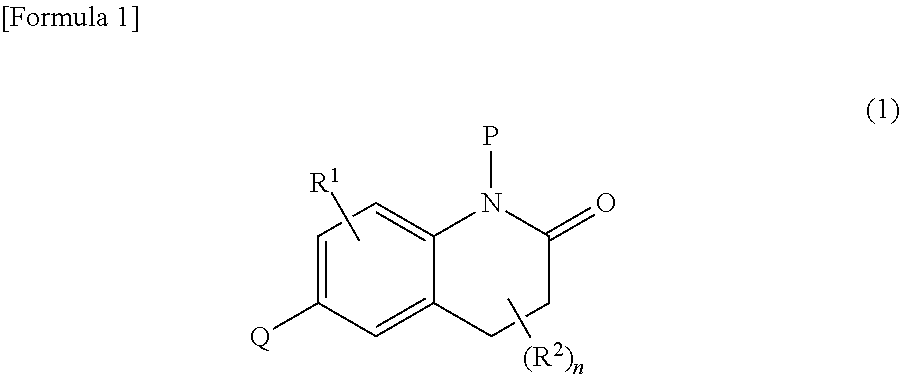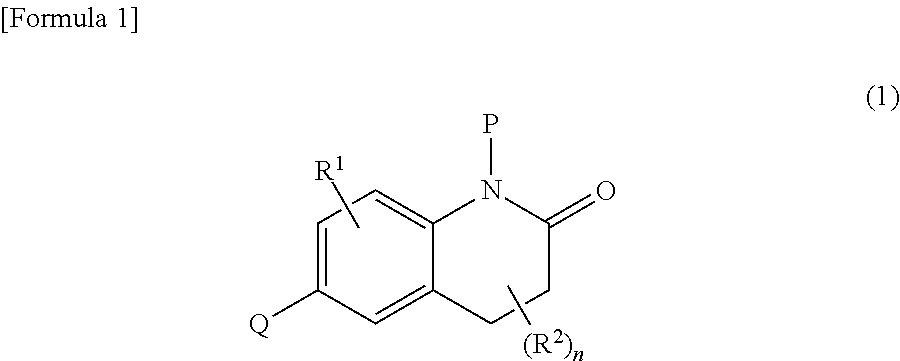Dihydroquinolinone derivatives
a technology of dihydroquinolinone and derivatives, which is applied in the field of dihydroquinolinone derivatives, can solve problems that have not yet been developed, and achieve the effect of excellent histamine h3 receptor antagonistic
- Summary
- Abstract
- Description
- Claims
- Application Information
AI Technical Summary
Benefits of technology
Problems solved by technology
Method used
Image
Examples
example 1
Preparation of 4-[6-{3-[(2R)-2-methylpyrrolidin-1-yl]propoxy}-2-oxo-3,4-dihydroquinolin-1(2H)-yl]benzonitrile (Compound No. 1)
(1) Preparation of (2R)-1-(3-chloropropyl)-2-methylpyrrolidine
[0219]
[0220]To a solution of (R)-2-methylpyrrolidine (18.0 g) and 1-bromo-3-chloropropane (100.0 g) in acetone (360 mL), 5M aqueous sodium hydroxide (50 mL) was added dropwise in an ice bath and stirred at 80° C. for 4 hours. The reaction mixture was cooled to room temperature and extracted with diethyl ether. The organic layer was washed with brine, dried over anhydrous sodium sulfate and concentrated under reduced pressure, and the resulting residue was purified by NH-type silica gel column chromatography (eluting solvent: n-hexane / ethyl acetate=4 / 1 to 1 / 1) and silica gel column chromatography (eluting solvent: chloroform / methanol=9 / 1) to give the titled compound (17.8 g, 52%) as a yellow oil.
(2) Preparation of (2R)-6-[3-(2-methylpyrrolidin-1-yl)propoxy]-3,4-dihydroquinolin-2(1H)-one
[0221]
[0222]T...
example 2
Preparation of 1-(1H-indol-5-yl)-6-{3-[(2R)-2-methylpyrrolidin-1-yl]propoxy}-3,4-dihydroquinolin-2(1H)-one (Compound No. 56)
[0284]
[0285]To a solution of tert-butyl 5-[6-{3-[(2R)-2-methylpyrrolidin-1-yl]propoxy}-2-oxo-3,4-dihydroquinolin-1(2H)-yl]-1H-indole-1-carboxylate (Compound No. 41) prepared in the same manner as shown in Example 1 (0.050 g) in methanol (0.19 mL), water (0.3 mL) and potassium carbonate (0.041 g) were added and stirred at 80° C. for 2 hours. The reaction mixture was concentrated under reduced pressure, and the resulting residue was purified by NH-type preparative TLC (on three plates of 0.25 mm thickness, developing solvent: ethyl acetate) to give the titled compound (0.0090 g, 2.2%) as a colorless amorphous substance.
[0286]1H NMR (600 MHz, CHLOROFORM-d) δ ppm 1.08 (d, J=6.4 Hz, 3 H), 1.36-1.46 (m, 1 H), 1.59-1.82 (m, 2 H), 1.85-2.01 (m, 3 H), 2.06-2.13 (m, 1 H), 2.14-2.21 (m, 1 H), 2.23-2.32 (m, 1 H), 2.79-2.87 (m, 2 H), 2.91-2.99 (m, 1 H), 3.01-3.09 (m, 2 H), ...
example 3
Preparation of 1-(1H-indol-3-yl)-6-{3-[(2R)-2-methylpyrrolidin-1-yl]propoxy}-3,4-dihydroquinolin-2(1H)-one (Compound No. 57)
[0288]
[0289]The same procedure as shown in Example 2 was repeated to give the titled compound, except that tert-butyl 5-[6-{3-[(2R)-2-methylpyrrolidin-1-yl]propoxy}-2-oxo-3,4-dihydroquinolin-1(2H)-yl]-1H-indole-1-carboxylate (Compound No. 41) was replaced by tert-butyl 3-[6-{3-[(2R)-2-methylpyrrolidin-1-yl]propoxy}-2-oxo-3,4-dihydroquinolin-1(2H)-yl]-1H-indole-1-carboxylate (Compound No. 42).
[0290]1H NMR (600 MHz, CHLOROFORM-d) δ ppm 1.08 (d, J=6.0 Hz, 3 H), 1.35-1.46 (m, 1 H), 1.62-1.82 (m, 2 H), 1.86-2.00 (m, 3 H), 2.06-2.13 (m, 1 H), 2.13-2.21 (m, 1 H), 2.22-2.32 (m, 1 H), 2.82-2.90 (m, 2 H), 2.90-2.99 (m, 1 H), 3.01-3.11 (m, 2 H), 3.11-3.19 (m, 1 H), 3.92-4.01 (m, 2 H), 6.47-6.51 (m, 1 H), 6.51-6.56 (m, 1 H), 6.80 (d, J=2.8 Hz, 1 H), 7.04-7.10 (m, 1 H), 7.16-7.24 (m, 2 H), 7.30 (d, J=2.8 Hz, 1 H), 7.38-7.44 (m, 1 H), 8.29 (br. s., 1 H)
[0291]MS (ESI / APCI Dua...
PUM
 Login to View More
Login to View More Abstract
Description
Claims
Application Information
 Login to View More
Login to View More - R&D
- Intellectual Property
- Life Sciences
- Materials
- Tech Scout
- Unparalleled Data Quality
- Higher Quality Content
- 60% Fewer Hallucinations
Browse by: Latest US Patents, China's latest patents, Technical Efficacy Thesaurus, Application Domain, Technology Topic, Popular Technical Reports.
© 2025 PatSnap. All rights reserved.Legal|Privacy policy|Modern Slavery Act Transparency Statement|Sitemap|About US| Contact US: help@patsnap.com



